10 Storytime Routines to Boost Toddlers’ Love for Books
Ever had that moment where your energetic toddler sits perfectly still, eyes wide, hanging on your every word during story time? If you’re frantically shaking your head “no,” you’re not alone.
Most parents struggle to keep their little ones engaged with books beyond the initial page-turning novelty. But here’s the secret: it’s not about the books—it’s about the experience you create around them.
Establishing consistent storytime routines for toddlers isn’t just about literacy; it’s about creating magical moments that make your child associate books with comfort, excitement, and connection.
I’ve spent years testing these approaches with my own kids and hundreds of families in my reading workshops. What I discovered might surprise you…
Creating the Perfect Reading Environment
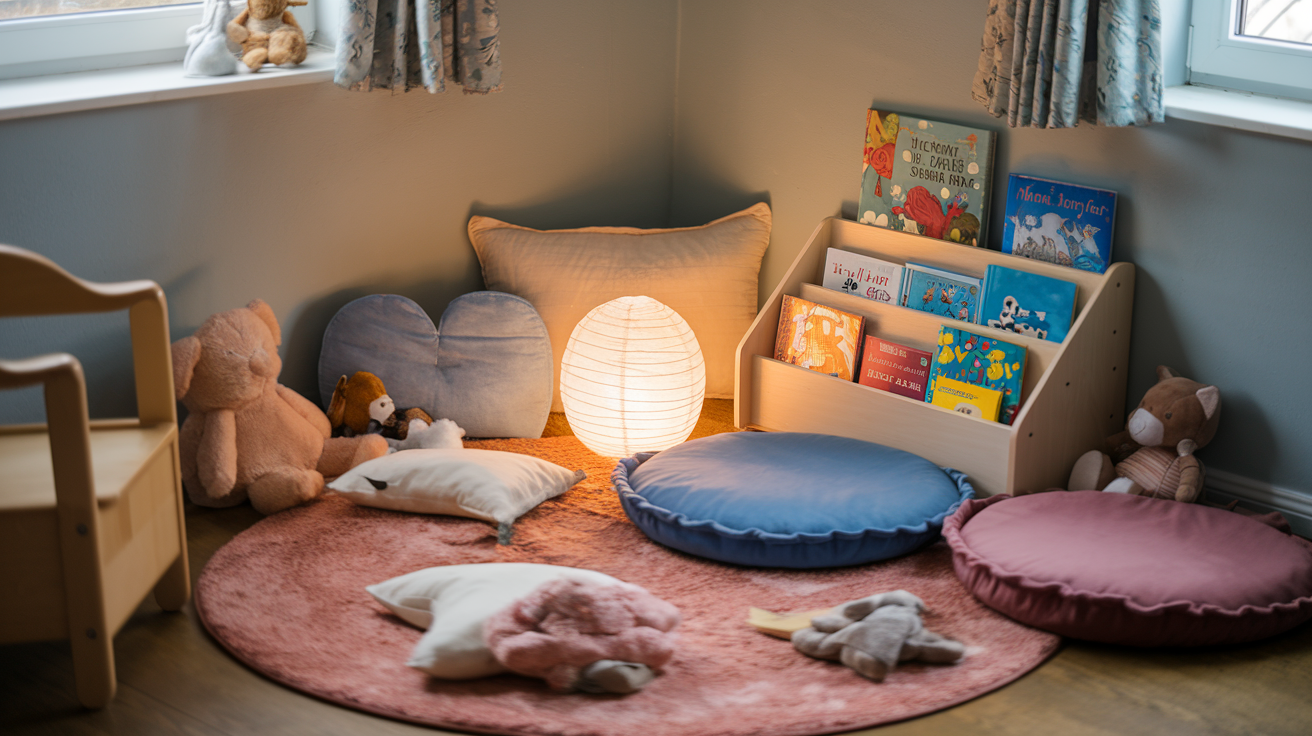
Setting up a cozy reading nook that sparks imagination
Your toddler’s reading space doesn’t need to be elaborate—it just needs to feel special. A corner with floor pillows, a small tent, or even a repurposed cardboard box can become their favorite spot to dive into stories.
Add some soft blankets and stuffed animals (book characters are a bonus!) to make it irresistibly cozy. The goal? Creating a space where your little one feels both safe and excited to explore new worlds through books.
Many parents swear by the “book nook rotation” trick—changing small elements every few weeks keeps the space feeling fresh and magical for young readers with growing attention spans.
Selecting appropriate lighting for different storytime moods
Lighting makes all the difference in how your toddler experiences a story. During daytime reading, natural light works wonders—position the reading nook near a window if possible.
For bedtime stories, soft, warm lighting helps signal that it’s time to wind down. A small lamp with a dimmer switch gives you control over the atmosphere. Some parents love using string lights for a touch of magic or a small projection night light that casts gentle patterns on the ceiling.
Want to make monster stories less scary? Keep the room brighter. Reading an adventure tale? Try a flashlight for dramatic effect. Your lighting choices actually help reinforce the emotional tone of whatever you’re reading.
Organizing books for easy access by your toddler
Toddlers are more likely to grab books when they can see the covers—not just the spines. Forward-facing bookshelves or rain gutter shelves mounted low on the wall make browsing simple for little hands.
Break your collection into categories that make sense to a toddler: animal books, bedtime stories, books with their favorite characters. You might use colored bins or picture labels to help them learn where everything belongs.
The golden rule? Keep their current favorites within easy reach, and rotate others in and out weekly. This prevents overwhelm while keeping their options fresh and exciting.
Using sensory elements to enhance the reading experience
Books are just the beginning—sensory elements can transform regular storytime into a multi-dimensional adventure. Try keeping a “story basket” with items that relate to favorite books: a small stuffed mouse for “If You Give a Mouse a Cookie” or different textured fabrics for “Pat the Bunny.”
Sound matters too. Background nature sounds for outdoor adventure stories or gentle ocean waves for beach tales can transport your toddler right into the setting.
Scents create powerful memory associations. A lavender sachet during bedtime stories or cinnamon sticks during holiday books creates connections that make reading time even more special and memorable.
For fidgety toddlers, having something to squeeze or hold often helps them focus longer on the story. Squishy stress balls, textured pillows, or even sensory bottles filled with colored water and glitter can keep hands busy while minds stay engaged with the narrative.
Establishing Consistent Reading Schedules
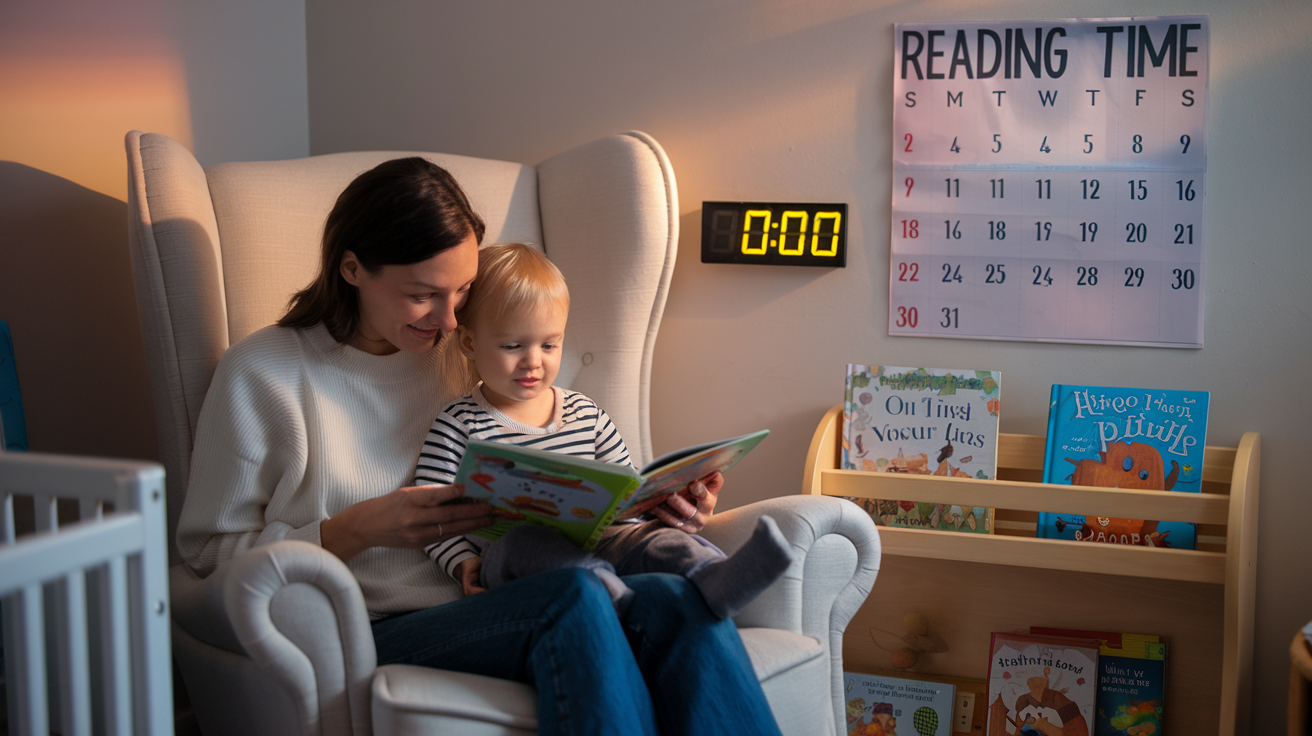
Benefits of reading at the same time each day
Kids thrive on routines. They just do. When you read with your toddler at the same time every day, you’re not just sharing a story—you’re building their internal clock and creating a sense of safety.
Ever notice how your little one seems calmer during regular activities? That’s because predictability reduces anxiety. When storytime happens at 7 PM sharp, toddlers stop fighting it and start looking forward to it.
Regular reading routines also help your child’s brain make connections. Their memory improves as they begin to anticipate what comes next in both their day and their favorite stories.
The bonus? You’re more likely to stick with daily reading when it has a dedicated spot in your schedule. No more “we forgot” or “maybe tomorrow.” It just happens—like brushing teeth or eating lunch.
Integrating books into morning routines
Mornings can be chaotic, but adding a quick story can actually make things smoother. Try keeping a basket of short books by the breakfast table. While your toddler munches, you read—multitasking at its finest!
Morning books work wonders because:
- Your child’s brain is fresh and receptive
- It starts the day on a positive note
- It associates reading with regular daily activities
Some parents swear by the “one book before we go” rule. Your toddler gets dressed faster knowing there’s a story waiting as their reward. Others create special morning-themed collections with titles about waking up, getting dressed, or starting new adventures.
The key is consistency. Even a three-minute story counts when it happens every morning!
The magic of bedtime stories
Bedtime stories aren’t just a delay tactic (though they work for that too). They’re powerful transition tools that help active toddlers downshift into sleep mode.
The bedtime story ritual creates a buffer between playtime and sleep. Your voice gets softer, the lighting dims, and your child’s body gets the message: time to wind down.
What makes bedtime reading special isn’t just the content—it’s the closeness. Your toddler snuggled against you, both focused on the same images, your voice the only sound in the room… these moments build attachment while building literacy.
Try creating a “bedtime books only” collection—special stories saved exclusively for this time. Many parents report their children requesting the same book night after night. Don’t fight it! This repetition is actually helping them master language patterns.
Weekend reading rituals that create lasting memories
Weekends offer the perfect opportunity to expand beyond your quick daily reads into more immersive book experiences. Think of these as your “special edition” reading times.
Family book picnics work like magic. Spread a blanket in the backyard or living room, bring snacks, and pile up books for an hour of reading together. The novelty makes books feel like a treat rather than a task.
Try these weekend book boosters:
- Visit the library together every Saturday morning
- Create themed reading forts with pillows and blankets
- Have “pajama book brunches” where everyone stays in PJs reading together
- Introduce “book and cook” Sundays where you read a story then make a related snack
These weekend rituals become the memories your children carry into adulthood—the special feeling of family togetherness around books.
How to maintain routines during travel or disruptions
Life happens. Vacations, illnesses, and holidays can throw even the best reading routines into chaos. But with a bit of planning, books can actually become your constant during disruptions.
Pack lightweight board books as non-negotiable travel items. They take up minimal space but provide maximum comfort when everything else is different. Digital options work too—load a tablet with e-books for long car rides or flights.
During home disruptions like moving or welcoming a new baby, reading routines become even more important. They signal to your toddler that some things remain steady even when everything else changes.
Smart parents create “emergency book bags” with a few favorites and some new titles. Pull these out during doctor’s waiting rooms, delayed flights, or those endless adult conversations when your toddler needs engagement.
Remember: an imperfect reading routine during disruption is better than abandoning it completely. Even a whispered story in a hotel bathroom while siblings sleep counts as maintaining your commitment to raising a reader.
Interactive Reading Techniques That Engage Toddlers
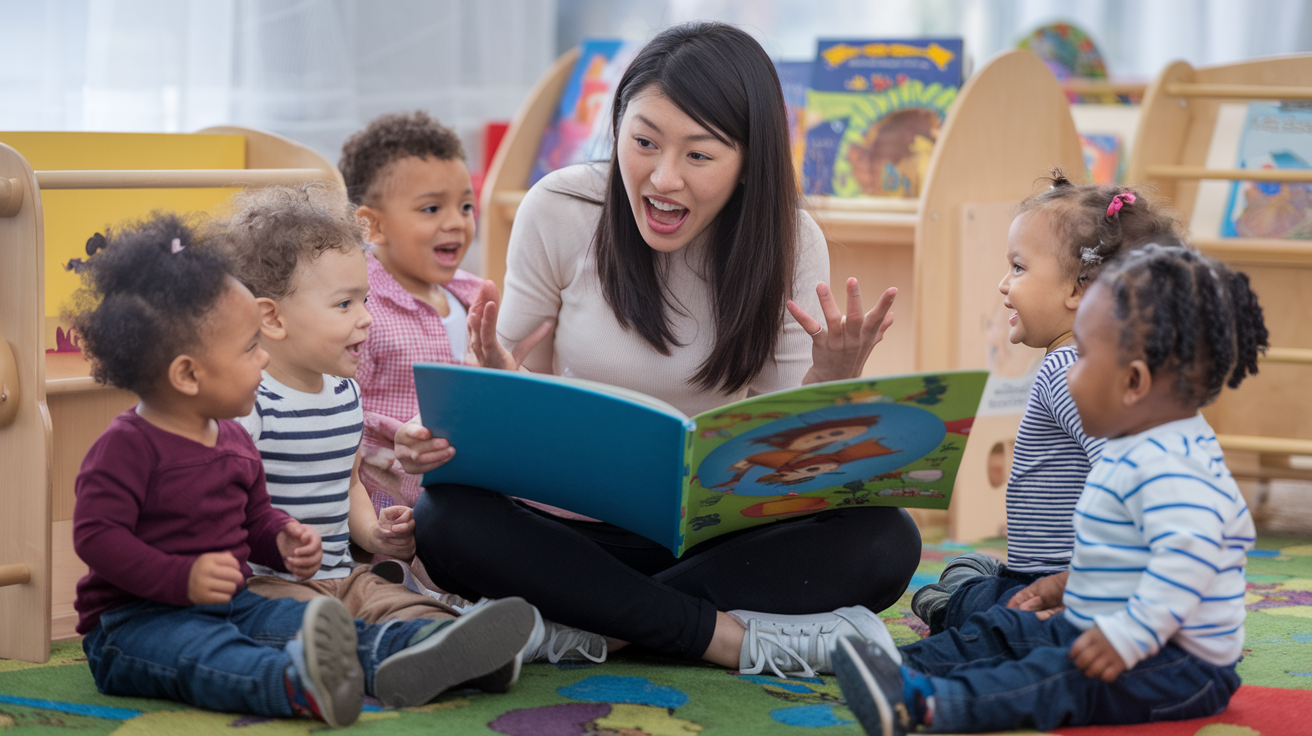
Using different voices for various characters
You know that moment when your toddler’s eyes light up because you’ve suddenly transformed into a growling bear or a squeaky mouse? Magic happens when you change your voice for different characters!
Little ones aren’t just listening to stories—they’re experiencing them. When you give the big bad wolf a deep, rumbly voice and the little pig a high-pitched squeal, you’re not just reading words on a page. You’re creating theater in their minds.
Try these voice variations:
- Whisper for shy characters
- Booming voice for giants or dinosaurs
- Sing-song voice for princesses or fairies
- Robotic voice for machines or robots
- Slow, sleepy voice for bedtime creatures
Don’t worry about sounding silly. That’s actually the point! Your toddler doesn’t care if your troll impression wouldn’t win any acting awards. They’re completely enchanted by your effort.
Encouraging questions throughout the story
Storytime becomes magical when it transforms from a one-way performance into a conversation. Pause regularly and ask your little one what they think about what’s happening.
Simple questions work wonders:
- “What do you think she’ll do next?”
- “Why do you think he feels sad?”
- “Have you ever felt like this character?”
But don’t just ask questions—encourage your toddler to ask their own! When they interrupt with “why is the bunny scared?” or “where did the duck go?”, celebrate these moments. These questions show they’re truly engaged.
Many parents worry interruptions ruin the flow of reading. Actually, the opposite is true! These little breaks create deeper connections to the story and build critical thinking skills.
Incorporating hand gestures and facial expressions
Reading with your whole body takes storytime from “meh” to “wow!” Your facial expressions and hand movements bring stories to life in ways words alone simply can’t.
When the character is surprised, open your eyes wide and gasp dramatically. For a sad moment, turn your mouth downward and slump your shoulders. Your toddler is watching everything—not just listening.
Try these crowd-pleasers:
- Flap your arms for flying creatures
- Wiggle fingers for rain or snow falling
- Puff cheeks for wind blowing
- Stretch tall for growing plants
- Curl up small for hiding characters
The beauty? You can invite your little one to join in! Before you know it, they’ll be mimicking your movements, creating a full-body storytime experience that builds motor skills while cementing story comprehension.
Pausing for predictions about what happens next
The most underrated reading technique? The strategic pause. Right before a big reveal or plot twist, stop reading and ask, “What do you think happens next?”
This simple move transforms passive listeners into active story detectives. Your toddler’s imagination kicks into overdrive as they consider possibilities based on the clues they’ve gathered.
Even when their predictions are wildly off (and they often will be), celebrate their creative thinking! Say things like “That’s such an interesting idea!” or “I never would have thought of that!”
The real magic happens over time. As you read the same books repeatedly (and you will…again and again), you’ll notice your little one’s predictions becoming more sophisticated. They’re learning story structure, cause and effect, and character motivation—all through what feels like play.
Incorporating Movement Into Story Time

Action-based Stories That Get Toddlers Moving
Toddlers have boundless energy. Why not channel it into storytime? Action-based stories are game-changers for fidgety little ones who struggle to sit still for traditional reading sessions.
Books like “We’re Going on a Bear Hunt” practically beg for movement – stomping through mud, swishing through grass, and tiptoeing into caves. “From Head to Toe” by Eric Carle invites kids to wiggle like a crocodile and bend their necks like giraffes. When my nephew was going through his “can’t sit still” phase, these interactive stories were our saving grace.
Try reading “The Very Hungry Caterpillar” while crawling around like hungry little caterpillars, then stretching those arms out to become beautiful butterflies. Watch how quickly your toddler becomes invested in the story when they’re physically participating.
Creating Simple Choreography for Favorite Books
You don’t need dance training to add simple movements to your child’s favorite stories. Start with these easy techniques:
- Assign a specific action to recurring phrases (jump when you hear “run, run as fast as you can” in The Gingerbread Man)
- Use different voices paired with specific postures for different characters
- Create a “story map” on the floor where you move to different spots for different scenes
The magic happens when your little one starts suggesting movements themselves! My friend’s daughter came up with the brilliant idea of spinning whenever the word “around” appeared in her books.
Using Finger Plays to Develop Fine Motor Skills
Finger plays aren’t just adorable – they’re developmental powerhouses. These mini hand-movement routines develop the precise motor skills needed for writing later on.
Beyond the classics like “Itsy Bitsy Spider” and “Five Little Monkeys,” try creating custom finger plays for your toddler’s favorite books. For “Brown Bear, Brown Bear,” let each finger represent a different animal. For counting books, raise fingers one by one.
The beauty of finger plays is they work anywhere – waiting rooms, car rides, or when you need a quick transition activity. They’re perfect for toddlers who need to move but are in situations where running around isn’t practical.
When you combine movement with storytelling, you’re not just building a love of reading – you’re creating multisensory experiences that connect with different learning styles and make stories truly memorable.
Extending Stories Beyond the Book

Creating crafts inspired by favorite stories
Books aren’t just for reading—they’re launching pads for creativity! After finishing a story, pull out some craft supplies and watch the magic happen. Just finished “The Very Hungry Caterpillar”? Grab some paper plates, paint, and pipe cleaners to create a caterpillar puppet. Read “Where the Wild Things Are”? Make wild thing masks using paper bags and art supplies.
The beauty of story-inspired crafts is how they cement the narrative in your toddler’s mind. When kids create something tangible related to a story, they process the tale on multiple levels. Plus, they get to keep a physical reminder of their favorite books.
Don’t worry about Pinterest-perfect results. The point isn’t creating frame-worthy art—it’s extending the joy of the story and building positive associations with reading.
Role-playing beloved characters after reading
Ever notice how your toddler wants to be Elsa or a superhero for weeks after encountering these characters? That’s the power of role play, and it works brilliantly with books too.
After reading, ask simple questions like, “Do you want to be the bear from the story?” or “Should we pretend we’re going on a bear hunt too?” Then follow their lead. You might:
- Set up a quick fort as Bear’s cave
- Pretend your living room furniture is the obstacles from “We’re Going on a Bear Hunt”
- Use stuffed animals as characters from the story
Role play helps kids internalize stories, build empathy by stepping into different characters’ shoes, and practice language they’ve just heard in the book.
Exploring real-world connections to book themes
Books come alive when kids see their real-world connections. Read a book about trains? Take a trip to watch real trains. Enjoyed a story about baking cookies? Head to the kitchen and make some together.
These connections transform stories from abstract concepts to tangible experiences. They show your child that books aren’t separate from “real life”—they’re all about real life.
Try pointing out connections as they happen naturally:
- “Look at that butterfly! It reminds me of the one in our story this morning.”
- “We’re picking apples just like the characters in our book!”
- “This rainy day is perfect for puddle-jumping like in our story!”
These moments teach kids that reading isn’t just a bedtime activity—it’s a lens for understanding their world.
Using storytime as a springboard for imaginative play
The end of a book doesn’t have to be the end of the story. Ask your toddler, “What do you think happens next?” or “What if the story had a different ending?”
This open-ended approach turns passive listening into active creation. You might:
- Set up a pretend store after reading a shopping story
- Build a blanket fort spaceship after a book about the moon
- Create small world play scenes using toys to recreate favorite stories
By treating books as starting points rather than complete experiences, you teach your child that stories live beyond pages. They learn that their imagination can extend any narrative—a powerful lesson that builds lifelong readers who see themselves as part of the storytelling process.
Building a Diverse and Engaging Book Collection

A. Rotating books to maintain interest and excitement
Ever noticed how your toddler gets bored with the same toys? Books work the same way. Creating a rotation system keeps your little one’s eyes lighting up every time you pull out a “new” book.
Try this: divide your books into three piles and store two-thirds out of sight. Every couple of weeks, swap them around. Your child will greet those returning books like long-lost friends!
“My daughter literally squeals when she sees books we haven’t read in a month,” says mom of two, Jenna. “It’s like she’s discovering them all over again.”
B. Selecting books that reflect your child’s interests
Got a dinosaur-obsessed toddler? A little one who’s crazy about trucks? Feed that passion!
When kids see their interests reflected in stories, magic happens. They’re not just listening anymore—they’re fully invested in the adventure.
Watch what makes your child stop and stare. Is it animals? Construction vehicles? Space? The weather? Use these observations as your book-hunting guide.
Remember: their interests will change faster than you can say “board book.” That truck fanatic might suddenly become obsessed with ocean creatures. Stay flexible and follow their lead.
C. Introducing diverse characters and perspectives
Books are windows to worlds beyond our own. When toddlers see characters who look different from them or live differently, they’re learning something invaluable—empathy.
Look for books featuring:
- Characters from various cultural backgrounds
- Different family structures
- Children with varying abilities
- Stories set in different countries
When reading, point out similarities: “Look, this little girl loves ice cream just like you do!” These connections help children relate to characters who might seem different at first glance.
D. Balancing familiar favorites with new discoveries
We all know the drill—reading “The Very Hungry Caterpillar” for the 87th time while silently wondering if you’ll ever read anything else again.
Here’s the thing: those repeat reads are actually golden for development. Your child is finding comfort in prediction and mastery. But their brain also craves new neural pathways.
Try the sandwich approach:
- Start with a familiar favorite
- Introduce something new in the middle
- End with another beloved book
This way, your child feels secure while still expanding their literary horizons.
E. Using library visits to expand reading horizons
Libraries are the ultimate playground for budding bookworms. And best of all? They’re free!
Make library visits a regular adventure. Let your toddler wander and pull books that catch their eye—even if they seem too old or too young. The act of choosing builds ownership and excitement.
Many libraries offer toddler story times where your little one can experience books in a social setting. These programs often introduce children to books you might never have discovered on your own.
Pro tip: Most libraries allow massive checkout limits. Take advantage! Grab 15-20 books each visit so you have plenty to rotate through before your next library date.
Making Books Part of Daily Conversations
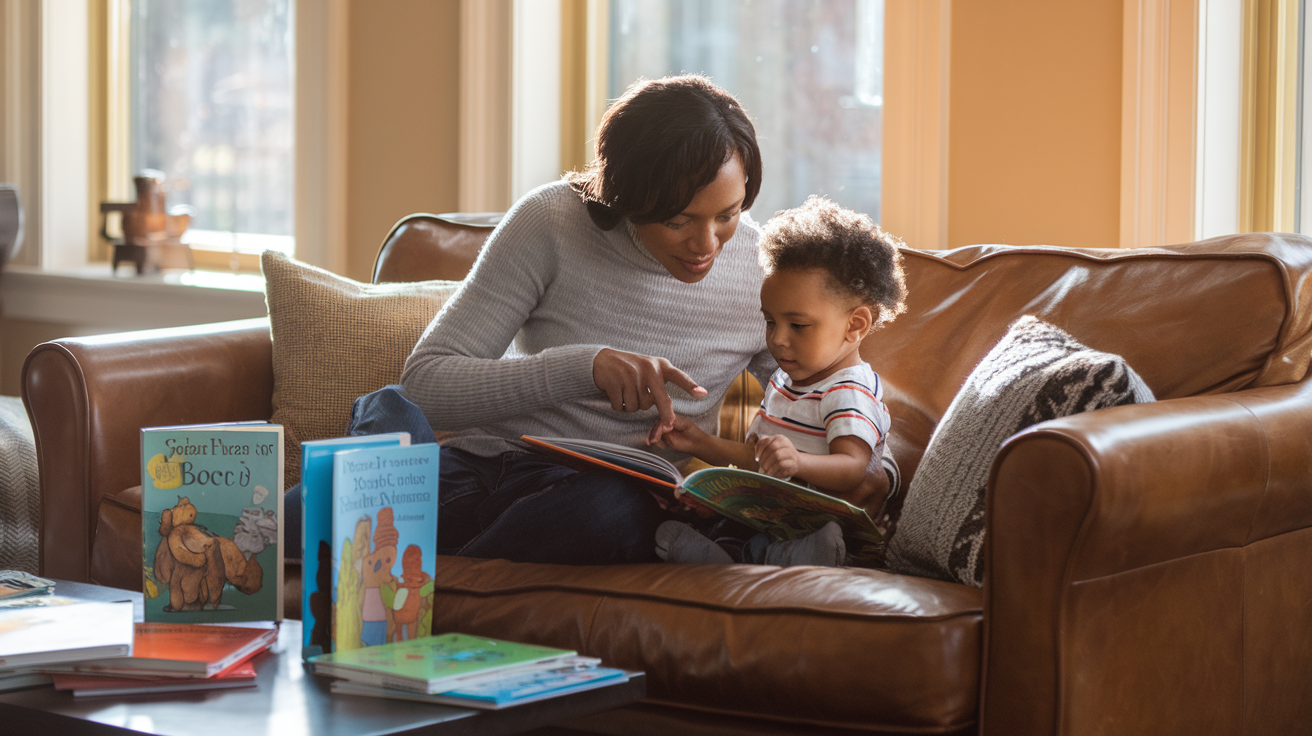
Referencing story characters during everyday activities
Books don’t have to stay on the shelf until bedtime. Your toddler’s favorite characters can join you throughout the day, making everyday moments more magical and meaningful.
When you’re getting dressed, try saying, “Let’s put on our red boots like Paddington Bear!” Or while washing hands: “We’re scrubbing away germs just like The Cat in the Hat cleaned up that big mess!”
I noticed my daughter was hesitant about trying new foods until I asked, “Do you think The Very Hungry Caterpillar would try this strawberry?” Suddenly, she was much more willing to take a bite.
This simple technique works because it:
- Creates continuity between storytime and daily life
- Makes routine tasks more fun and engaging
- Reinforces character recognition and story recall
Using book themes to help navigate emotions
Books are powerful tools for emotional learning. When your toddler is struggling with big feelings, the right story reference can help them process what’s happening.
My son was terrified of his first haircut until we read “The Hair Cut” the night before. During his appointment, I whispered, “Remember how Zach felt scared but then was so proud of his big-kid haircut?” The tears stopped immediately.
When sharing toys becomes an issue, remind them how the Rainbow Fish learned that sharing made him happier. For separation anxiety, Daniel Tiger’s “grown-ups come back” song works wonders.
Creating connections between books and real-life experiences
The real magic happens when children start seeing their own lives reflected in stories—and stories reflected in their lives.
When you spot a ladybug in the garden, exclaim, “Look! Just like in The Grouchy Ladybug!” At the grocery store: “Should we count apples like The Very Hungry Caterpillar?”
Take it further by planning activities inspired by favorite books:
- Bake bear-shaped cookies after reading Corduroy
- Visit a fire station after reading Fire Truck books
- Plant seeds after reading The Tiny Seed
These connections help toddlers see reading as relevant to their world, not just an isolated activity. My daughter spotted a spider web and announced, “That’s Charlotte’s house!” I knew then that stories had become part of how she sees everything around her.
Using Technology to Enhance (Not Replace) Physical Books

Age-appropriate audiobooks to support reading development
Gone are the days when audiobooks were seen as “cheating” at reading. They’re actually amazing tools for boosting your toddler’s language skills! Quality narrators bring stories to life with expressive voices that teach proper pronunciation and natural speech rhythms.
Start with short audiobooks (5-10 minutes) that match physical books you already own. Let your little one follow along with the pages as they listen. Many libraries offer free audiobook borrowing through apps like Libby or Hoopla.
Great starter audiobooks include:
- “The Tale of Peter Rabbit” narrated by Meryl Streep
- “Llama Llama Red Pajama” read by the author Anna Dewdney
- Disney’s “Read-Along” series with sound effects and page-turning signals
Apps that extend favorite stories in meaningful ways
The best story apps don’t just digitize books—they create interactive experiences that deepen comprehension. Look for apps that:
- Highlight words as they’re read
- Allow recording your voice reading the story
- Include gentle animations that support (not distract from) the narrative
Epic! and Khan Academy Kids offer curated libraries with story extensions like character-based games and comprehension activities. My top pick? The “Pat the Bunny” app transforms the classic touch-and-feel book into touchscreen interactions that maintain the original’s sensory exploration.
Video calls with relatives for long-distance storytime sessions
Grandparents who live far away can still be storytime heroes! Set up regular video storytime sessions where relatives read to your child. This creates beautiful bonding moments while supporting literacy.
Quick tips:
- Ship duplicate copies of books to relatives so everyone has the same book
- Position the camera so your toddler can see both the reader’s face and the book pages
- Keep sessions under 15 minutes for toddler attention spans
- Try “echo reading” where the distant reader reads a line, then your toddler repeats it
Recording your own readings for times when you’re unavailable
Working late? Business trip? Your voice reading beloved stories can still comfort your child when you can’t be there in person.
Apps like Readeo and StoryTime let you record yourself reading books. But even a simple voice memo works! Record yourself reading your child’s favorites with all the silly voices and sound effects you normally use.
Some parents create a special “Mommy/Daddy Reading Library” of recordings that caregivers can access. The familiar voice and reading style maintains consistency in your storytime routine even when you’re away.
Creating Special Reading Traditions
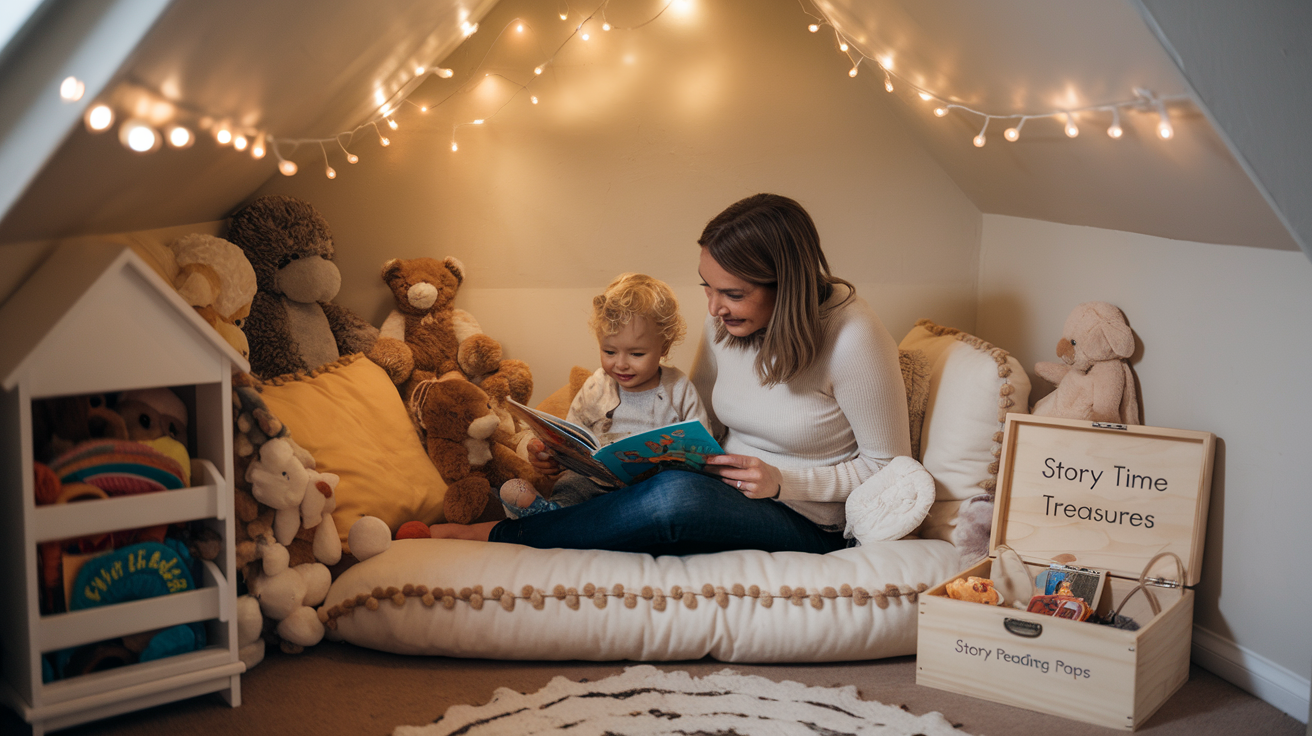
Weekly library adventures to discover new books
Reading shouldn’t be confined to your living room! Taking your toddler on weekly library trips creates a magical routine they’ll look forward to. The children’s section of libraries is basically toddler paradise—colorful bean bags, tiny tables, and shelves upon shelves of undiscovered stories.
My friend Sarah started “Friday Library Days” with her daughter Emma, and now the 3-year-old literally wakes up on Fridays asking, “Is it library day?!” Kids thrive on these consistent adventures.
Make it extra special by creating a little ritual around it:
- Let them carry their own special library tote bag
- Allow them to choose 3-5 books completely on their own
- Find a cozy spot in the library to read one book before heading home
- Stop for a small treat afterward (nothing says “books are awesome” like pairing them with a mini cupcake!)
Book-themed birthday celebrations
Want to make reading feel like the coolest thing ever? Throw a party that brings their favorite book to life!
Picture this: A “Very Hungry Caterpillar” party with fruit stations, caterpillar crafts, and butterfly releases. Or a “Where the Wild Things Are” celebration with monster masks and a wild rumpus dance party.
The beauty of book-themed parties is they connect reading with pure joy. Your child’s friends will all go home wanting to read the featured book, too!
Some simple ideas that won’t break the bank:
- Send invitations that look like tiny books
- Ask guests to bring a favorite book instead of a gift for a book exchange
- Create simple costumes or props from the featured story
- Read the book dramatically as the party entertainment
Seasonal reading rituals that children anticipate
Nothing gets kids excited like special books that only appear during certain times of the year. It’s like reuniting with old friends!
Many families have Christmas book collections they unwrap each December, but why stop there? Create reading traditions for every season:
- Spring: Seeds and growing themed books paired with actual planting activities
- Summer: Beach and adventure books stored in a special “vacation” basket
- Fall: Apple picking and pumpkin stories that come out with the first crisp day
- Winter: Snowman and hibernation tales kept in a special winter chest
My neighbor’s kids literally cheer when the “autumn book basket” comes down from the attic. They instantly want to cuddle up with their returning favorites.
Family book clubs that grow with your child
Think book clubs are just for adults? Think again! Even the tiniest readers can participate in family book discussions.
Start super simple with toddlers:
- Everyone reads the same picture book
- Have a special snack related to the story
- Talk about favorite parts or characters
- Draw pictures about the book
As your child grows, your book club grows too. By elementary school, you can read chapter books together and have deeper conversations. By middle school, you might be tackling literature that sparks important family discussions about values and life lessons.
The magic happens when reading becomes something you do together—not just a bedtime activity, but a shared experience that creates lasting connections.
Measuring and Celebrating Reading Progress
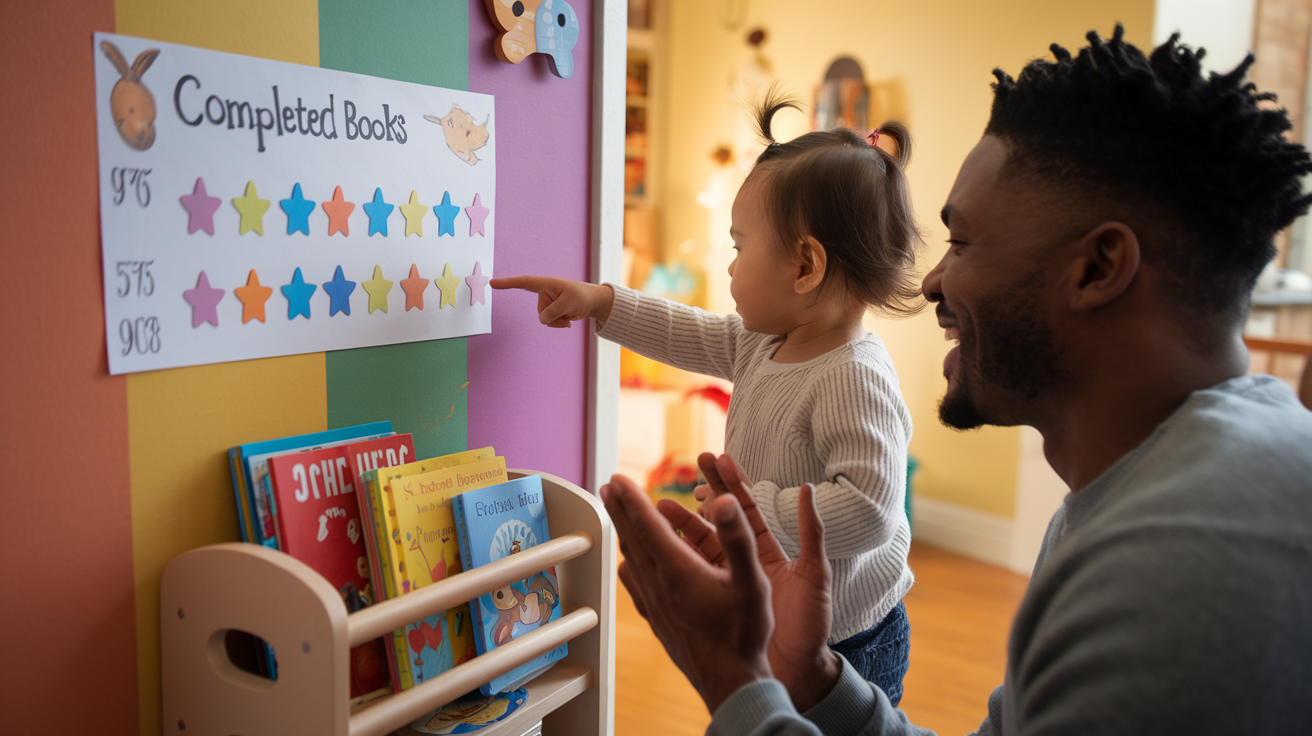
Creating simple reading journals with your toddler
Ever watched your little one’s eyes light up when they discover a new book? That magic deserves to be remembered! Creating a reading journal with your toddler isn’t just adorable—it’s a powerful way to track their growing love for stories.
Start with something simple: a notebook decorated with your child’s favorite stickers or drawings. After each storytime, help them add a stamp, sticker, or even a scribble for books they’ve enjoyed. For older toddlers, try taking photos of book covers and pasting them in, adding a happy or sad face to show if they liked it.
My friend Sarah uses colorful thumbprints with her 2-year-old—red for books they absolutely loved, blue for ones they’d like to read again, and yellow for new discoveries. No pressure, just fun!
Recognizing new vocabulary learned through books
Books are vocabulary goldmines for toddlers! When your little one points to a picture and says “excavator” instead of “big truck” for the first time, that’s book magic happening.
Keep a running list of surprising words your toddler picks up from reading together. Notice how they start using these words in everyday conversations—it’s mind-blowing how quickly they absorb language from stories.
Try this game: after reading a book a few times, pause before saying key words and see if your toddler fills them in. When they nail it, make a big deal out of it! “Wow! You remembered ‘chrysalis’ from The Very Hungry Caterpillar!”
Many parents swear by the “word jar” method—dropping a pom-pom in a clear jar whenever their child uses a new book-inspired word. When the jar fills up, celebrate with a special outing or a new book!
Celebrating reading milestones in meaningful ways
Toddlers thrive on celebration, and reading accomplishments deserve some serious fanfare! But forget the generic sticker charts—personalized celebrations make a bigger impact.
When your little bookworm reaches 50 books, create a special “reading fort” with pillows, fairy lights, and their favorite stuffed animals. Hit 100 books? Plan a themed picnic based on their favorite story.
One mom I know takes her daughter to the local bakery for a special cookie whenever they finish reading all the books by a particular author. Another family has “book character dinners” where everyone dresses up like characters from a beloved story.
The point isn’t expensive rewards—it’s marking these moments as special. Even something as simple as taking a monthly photo of your toddler with their current favorite book creates a meaningful timeline of their reading journey.
Sharing your child’s reading journey with family members
Grandparents, aunts, uncles, and distant cousins often miss out on day-to-day reading moments with your toddler. Bringing them into the experience creates a community of reading supporters for your child.
Video calls work wonders—schedule regular “virtual storytime” where relatives read to your toddler or listen to them “read” a familiar book. My sister’s father-in-law reads the same bedtime story to his grandson every Tuesday night, despite living 2,000 miles away.
Create a shared digital album where family members can see what books you’re enjoying together. Better yet, start a family book club where relatives send your toddler books they loved as children, along with a note explaining why the book is special to them.
When family visits, encourage your toddler to show off their reading journal or demonstrate how they can now “read” certain parts of favorite books from memory. Those proud smiles from adults reinforce that reading is valued by everyone who loves them.
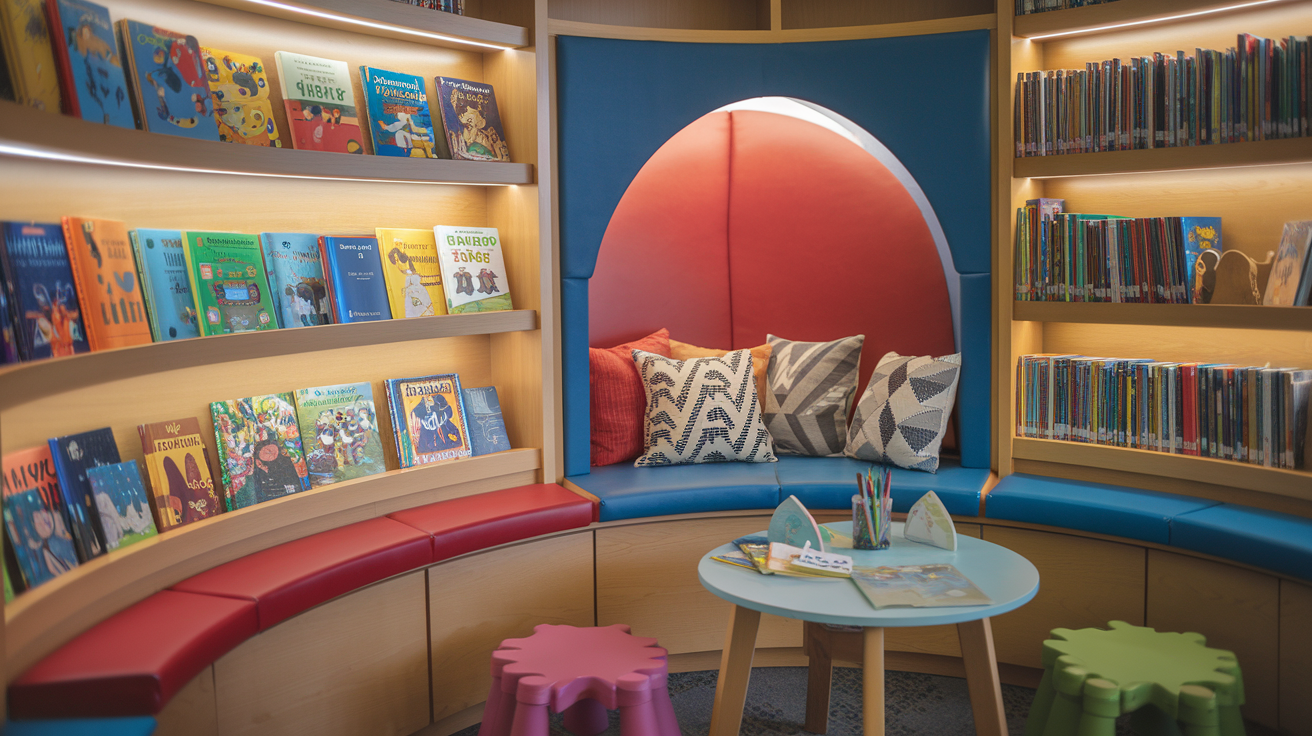
Fostering a love for books in toddlers is a journey that begins with thoughtful routines and consistent engagement. By creating cozy reading environments, establishing regular reading schedules, and employing interactive techniques, you’re laying the foundation for lifelong learning. Incorporating movement, extending stories beyond pages, and building diverse book collections further enriches their experience, while making books part of everyday conversations helps children see reading as an integral part of life.
The joy of reading flourishes when we balance technology with physical books, create special reading traditions, and celebrate each milestone in a child’s reading journey. Remember, the habits you establish today aren’t just about literacy skills—they’re about nurturing curiosity, empathy, and imagination that will serve your little one throughout their life. Start implementing these storytime routines today, and watch as your toddler’s enthusiasm for books blossoms into a passion that will open countless doors in their future.

















Reading with toddlers is such a special way to bond and spark their imagination. Creating a cozy, inviting space can make all the difference in keeping them engaged. Simple touches like soft blankets, pillows, and warm lighting can transform storytime into a magical experience. Rotating elements in their reading nook keeps it exciting and fresh for their curious minds. How do you make storytime a memorable and enjoyable routine for your little one?